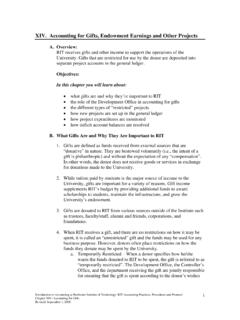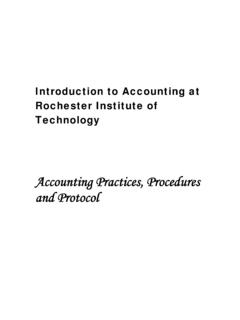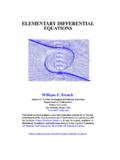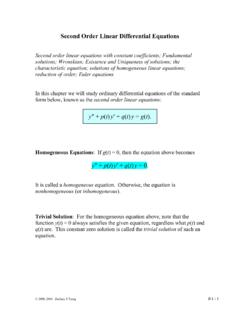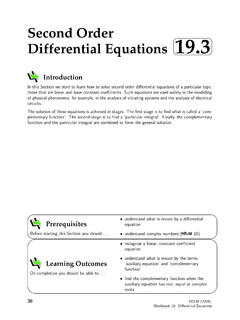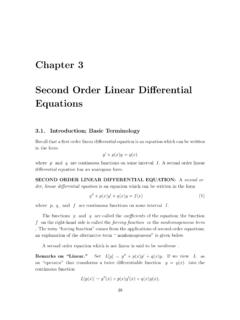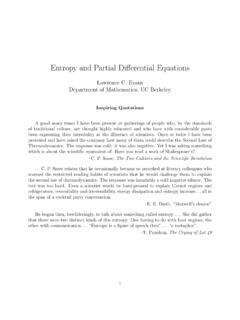Transcription of Non-Homogeneous Second Order Differential Equations
1 Non-Homogeneous Second Order Differential Equations Procedure for solving Non-Homogeneous Second Order Differential Equations : y" p( x) y' q( x) y g ( x). 1. Determine the general solution y h C1 y( x) C2 y( x) to a homogeneous Second Order Differential equation: y" p( x) y' q( x) y 0. 2. Find the particular solution y p of the Non-Homogeneous equation, using one of the methods below. 3. The general solution of the Non-Homogeneous equation is: y( x) C1 y( x) C2 y( x) y p where C1 and C2 are arbitrary constants. METHODS FOR FINDING THE PARTICULAR SOLUTION (yp ) OF A NON- HOMOGENOUS EQUATION.
2 Undetermined 1. Write down g(x). Start taking derivatives of g(x). List all the Coefficients. terms of g (x) and its derivatives while ignoring the coefficients. Restrictions: Keep taking the derivatives until no new terms are obtained. 1. must have constant 2. Compare the listed terms to the terms of the homogeneous coefficients: solution. If one or more terms are repeating, then the recurring ay" by' c g ( x) expression needs to be modified by multiplying all the repeating 2. g(x) must be of a terms by x. certain, easy to guess 3.
3 Based on step 1 and 2 create an initial guess for yp. form. 4. Take the 1st and the 2nd derivatives of yp. Plug into the Differential equation. Solve for the constants. 5. Plug the values of the constants into yp. Variation of y 2 ( x) g ( x) y ( x) g ( x). Parameters. y p ( x) y1 dx y 2 1 dx W ( y1 , y 2 )( x) W ( y1 , y 2 )( x). where y1 and y2 are solutions to the homogeneous equation and y y2. W ( y1 , y 2 )( x) 1 y1 y 2 y 2 y1 . y1 y 2 . The set of solutions is linearly independent in I if W ( y1 , y 2 )( x) 0 for every x in the interval.
4 Or equivalently: y p ( x) v1 y1 v2 y 2. where y1 and y2 are solutions to the homogeneous equation and v1 and v2 are unknown functions of x. To determine v1 and v2, solve the following system of Equations for v 1 and v 2. y1v1 y 2 v 2 0. y1 v1 y 2 v 2 g ( x). Integrate v 1 and v 2 to find v1 and v2. Substitute v1 and v2 into y p ( x) v1 y1 v2 y 2. Example #1. Solve the Differential equation: y 2 y t e t Solution: 1. homogeneous equation: y 2 y 0. Characteristic equation: r 2 2r 0. r (r 2) 0. r 0, r 2. yh C1 C2 e 2t 2. Particular solution: The constant is already in the g (t ) t e t t, et homogeneous solution.
5 Multiplying it by t will repeat the g ' (t ) 1 e t Terms: C , e t terms of g(t). So we need to g " (t ) e t et No new terms. modify both the constant and the t. Initial guess of yp y p ( At B) Ce t . Part of a homogeneous solution. Both terms need to be modified Modify yp: y p t ( At B) Ce t At 2 Bt Ce t y p 2 At B Ce t y" p 2 A Ce t Plug the yp and its derivatives into the original Differential equation: y 2 y t e t implies 2 A Ce t 2 2 At B Ce t t e t 2 A 2B 4 At Ce t t e t . C 1 C 1. 1. 4A 1 A . 4. 1. 2 A 2B 0 B . 4. t2 t t So y p e t (t 1) e t and the general solution is: 4 4 4.
6 Y yh y p t y C1 C 2 e 2t (t 1) e t 4. et Example #2. Solve the Differential equation: y 2 y y . t 1. homogeneous equation: y 2 y y 0. Characteristic equation: r 2 2r 1 0. (r 1) 2 0. Not an easy to guess . r 1, r 1 function. It is a quotient so the derivatives will get more yh C1e C2 te t t complicated, making it impossible to list all terms. y1 e t and y 2 te t y'1 e t and y' 2 te t e t 2. Particular solution: W ( y1 , y 2 )( x) det y1. y1 . y2. y 2 . et det t te t . e t te t e t te t e t te 2t e 2t te 2t e 2t e te e t t So y 2 ( x) g ( x) y ( x) g ( x).
7 Y p ( x) y1 dx y 2 1 dx . W ( y1 , y 2 )( x) W ( y1 , y 2 )( x). et et te t et . e t t dt e t 1dt te t 1dt te t te t ln t t t dt te t 2t 2t e e y p (t ) te t te t ln t and the general solution is: y C1e t C2 te t te t te t ln t C1e t C3te t te t ln t You try it: 1. y" y' 2 y sin 2 x 2. y" 2 y' y xe x 3. y" y sec x Solutions: 3 1. #1: y C1e x C 2 e 2 x sin 2 x cos 2 x 20 20. 1. #2: y C1e x C 2 xe x x 3 e x 6. #3: y C1 cos x C2 sin x cos x ln cos x x sin x

